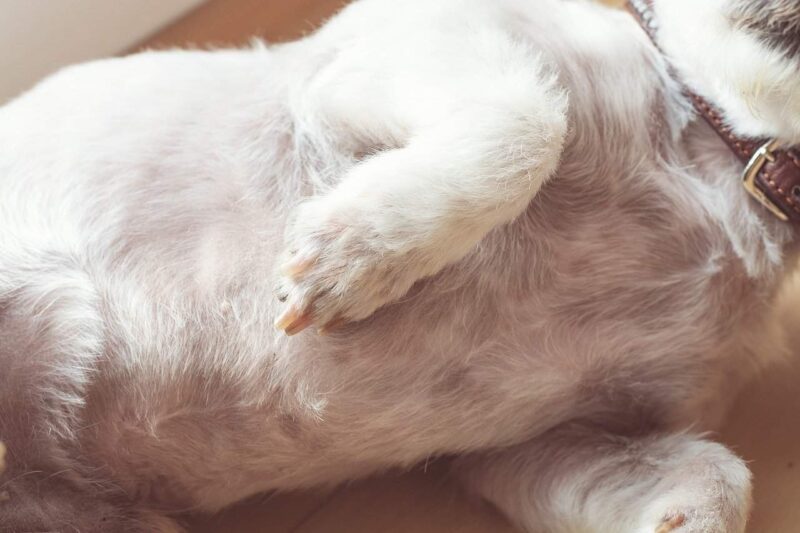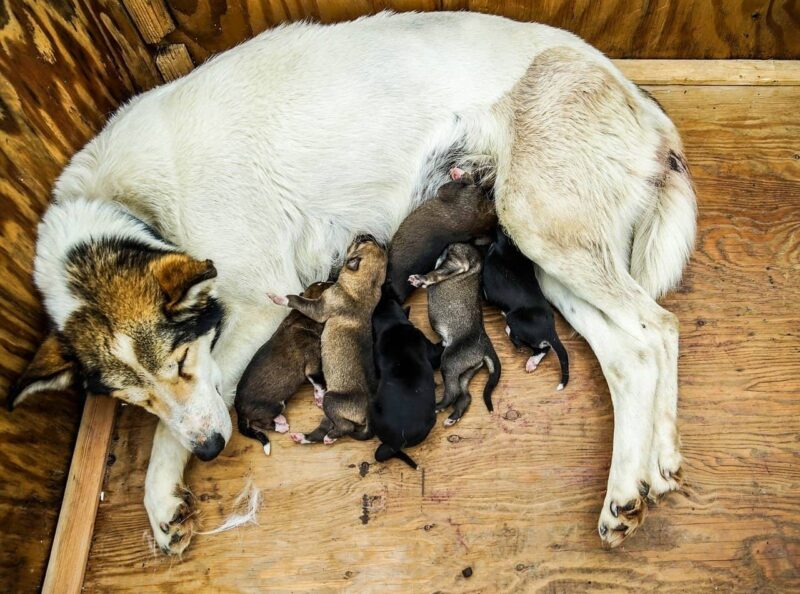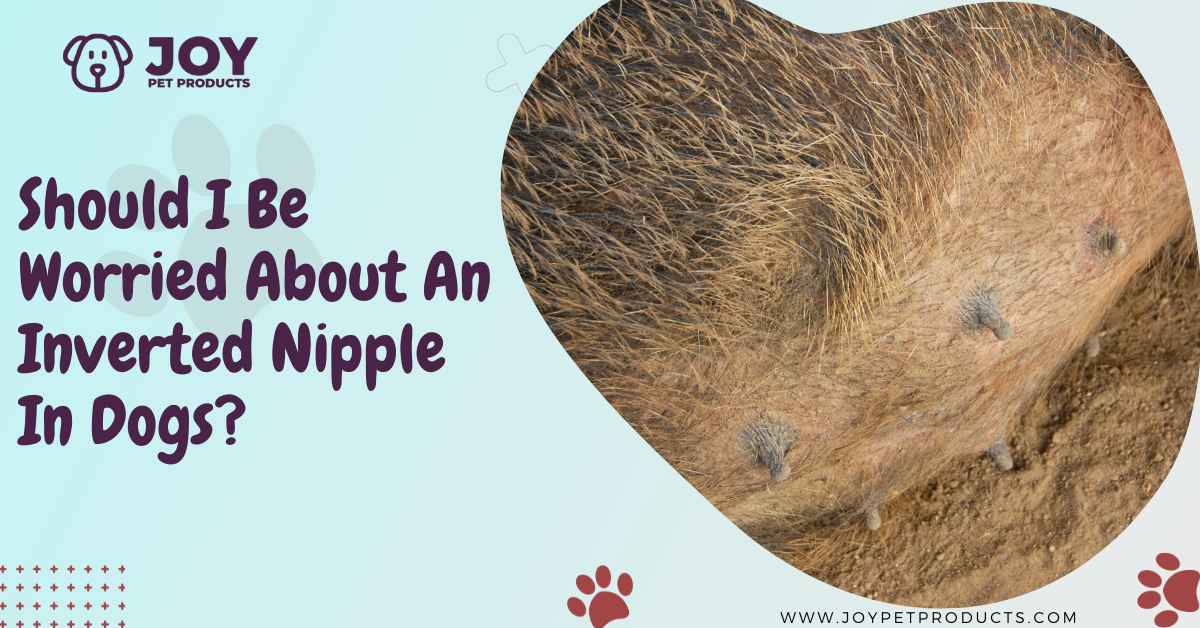As you give your dog its tenth belly rub of the day, you brush the fur near its lower belly- and see something that’s escaped your notice till now.
There seems to be a small, dark, sunken hole where your dog’s nipple is meant to be!
As the initial cold shiver of shock runs down your spine, you quickly assess the cratered area with your hands. There aren’t any visible signs of swelling or redness, and your dog doesn’t seem to be in pain.
As the truth dawns, your worry slowly subsides and turns into guarded curiosity. You wonder to yourself,
“Should I be concerned about an inverted nipple in dogs?”
Actually, it is quite common to see dogs with reversed nipples. So much so that when you take them to the vet, he probably won’t even give them a second thought!
In addition to being inverted, the nipples may also have turned black, or have a waxy, dark substance surrounding them.
Why Do Dogs Get Inverted Nipples?
(Side note: I am a member of the Amazon Associates program. From time to time I like to recommend products in my posts that I feel may truly be helpful to readers and their pets. If you do end up buying something by clicking the links on my site, I may receive a tiny amount of commission from the big guys.
And if you do end up buying something- Thank you! I really appreciate your support and I’ll always do my best to put out more quality content for you 🙂 )
As it turns out, it’s pretty normal for a puppy to develop inverted nipples as it matures into adulthood. Usually they’re not much of an issue- just like your regular canine nipples, except, well, upside down.
While inverted nipples can occur on both male and female canines, they are usually more noticeable on pregnant or nursing dogs. This is because newborn puppies need milk from their mother, and the presence of reversed nipples may make feeding more difficult.
Like male dogs with multiple nipples, inverted nipples are just another unique part of your dog’s body. So rest assured- there’s nothing inherently wrong with your pup, and it doesn’t suffer just because it has them and other dogs don’t.
If you’re worried about how they look- they’re barely noticeable among the fur, and also why are you looking so closely at a dog’s nipples anyway?!
That’s not to say that issues can’t arise. Due to the nature of the nipples being sunken in, they act as a conduit that becomes more likely to trap dirt and bacteria. As a result, it is quite common for inverted nipples on dogs to turn black, or to have lots of crusty, odorous build-up.
If they are not cleaned regularly and thoroughly, this can of course lead to a higher chance of infection or something called mastitis, which will be explored further below.
If your dog is already well into adulthood and has only recently developed transposed nipples, that is a change to your dog’s body that warrants more careful observation.
Has your dog been acting strangely in other ways recently? Have there been any noticeable changes in meal and bathroom habits?
Is there any swelling, redness, swelling, or discharge around the nipple area? Are there signs of bleeding or spreading rashes?
If you notice any of these symptoms, there may be something more ominous happening inside your dog’s body or around that area, such as hormonal imbalances, surface trauma or infection.
The only truly accurate way to know what is going on with your pup is to take it to the vet for an examination. The vet will be able to conduct blood tests and take samples and cultures from the area to determine if there is a harmful organism present.
Then, he will be able to prescribe proper treatment for your dog so that it gets back to being its normal, healthy self as quickly as possible!
How To Treat Inverted Nipples On A Dog?

Add one more thing to the list of incredible things that we, as dog owners, are willing to do for our dogs.
Not only do we disinfect their mouth after they eat poop, comfort them when they’re afraid, and give them the best supplements that we can find- now we’re relied on to clean their inverted nipples too?!
Yes, yes we are.
Cleaning your dog’s upturned nipples (if it has them) is just as much a part of grooming as clipping nails, brushing fur, and feeding them an optimal diet.
And when our fur babies show us they love and appreciate us back by burying their heads in our laps– that’s what makes it all so worth it.
With that said, if your dog naturally has inverted nipples, it is important to clean them on a daily basis with a damp cloth in or baby wipes in order to prevent the risk of infection.
Keeping the area clean will help to lessen the sebum build-up and stop dirt and debris from being collected. It will also help your dog smell nicer as deeply-embedded gunk is removed.
While dogs are able to clean some parts of their body by licking themselves, most of the time their tongue is much too big to reach inside the relatively tiny pores of inverted nipples. Therefore, the only way to clean the area is through human intervention.
While some dogs don’t mind the process, most probably won’t enjoy the sensation very much. They will likely squirm and try to escape as you endeavor to remove the muck from their reversed nipples.
That’s why it’s so important to get your dog used to being touched everywhere when they are still young. This will pay dividends down the road whenever you need it’s trust when you are attending to areas that need first aid.
What Wipes Should I Use To Clean My Dog?

The ideal wipes to clean your dog’s inverted nipples is the Earth Rated Dog Wipes.
These unscented, moist and soft wipes have a range of beneficial properties including:
- Ultra-durable
- Hypoallergic
- Does not use alcohol, paraben or sulfate
- Contains aloe, chamomile and Shea butter
Earth Rated Dog Wipes are also USDA-Certified 99% bio-based, compostable, and cruelty-free.
With a 4.7 out of 5 star rating from over 14,100+ satisfied customers, these wipes are recommended to clean your dog’s inverted nipples and any other parts of your dog’s body.
How To Prevent A Dog Inverted Nipple Infection?

Even if you choose not to clean them everyday (which honestly you may not need to as some dogs don’t get as dirty), it’s vital to check the status of the nipple at least fortnightly or monthly.
Most likely, dirt and wax will have collected and will need to be squeezed out- much like a blackhead. Having the visual appearance of a black spot, it may easily be mistaken for a sebaceous cyst or particularly inflamed pimple.
As grime, dirt and sand gather inside the pocket, it may understandably become itchy for the dog. This could result in intensive scratching, which could then cause broken skin and bleeding. This will only add to the infection risk.
Bathing usually won’t be sufficient to clear an inverted nipple properly, and if grime and bacteria are allowed to remain inside, it could become inflamed and irritated. The nipple can typically be ‘popped out’ temporarily by stretching the skin, allowing for easier cleaning.
It’s a good idea to follow up cleansing with water by wiping the skin down with an antiseptic or antimicrobial substance like Betadine, coconut oil or witch hazel. Epsom salts dissolved in water make a good disinfecting solution too; just make sure your dog doesn’t eat any!
If the inverted nipple isn’t regularly cleaned and subsequently becomes infected, it could become quite serious. Usually it will then have to be treated by the vet through prescribed antibiotics, which as you can imagine can become rather expensive.
Click on the image above to
buy Betadine Antiseptic Solution
from Amazon!
Mastitis
One particular bacterial infection that can affect dog nipples, normal or inverted, is mastitis. It describes an inflammation of the mammary gland, usually caused by trauma to the nipple area.
According to the Merck Veterinary Manual, it can also be caused by poor sanitary conditions and systemic infection. If left untreated, it can become a life-threatening ailment.
While it is often seen in intact female dogs- especially those that just had puppies- it is possible for spayed females and male dogs to develop mastitis as well.
Signs of mastitis can include:
- Lethargy
- Refusal to eat
- Fever
- Vomiting
- Swollen mammary glands leaking pus.
What Should I Do If My Female Dog Has Inverted Nipples And Has Trouble Feeding Her Puppies?

While most intact female dogs will have well-developed nipples, it isn’t uncommon for them to also possess a few inverted ones. This becomes most evident when the dog has puppies and begins nursing.
You may notice that the smaller, weaker puppies constantly miss out on milk. This is due to them being pushed aside by their littermates for the available nipples, and then being unable to find or latch onto inverted ones.
At some point, it becomes a mathematics problem: When there are 12 puppies and only 6 available, easily-accessible nipples, some are bound to miss out. However, miss out for too long, and it becomes a life-threatening scenario.
There are a few things that you can do in such situations:
- If the mother dog usually lies on one particular side, inconveniently concealing protruding nipples while showing the inverted ones, try to reposition her so that the puppies have easier access.
- Manually rotate the puppies by giving them access to their mother a few at a time. This way, they will get as equal an amount of milk as possible. This will also prevent bigger puppies from always barging the smaller ones out of the way.
- Identify the strongest puppy of the litter, and put it on the inverted nipple. This should help to correct the nipple position, at least while feeding. You can bring the nipple out initially by stretching the skin back.
Inverted nipples on pregnant or nursing dogs are at particular risk for developing mastitis, since there may also be the added factor of prolonged milk accumulation without milk removal.
Therefore, you must be diligent in monitoring the state of a inverted nipple on a nursing dog at all times!
In Summary
Though unexpected, it is quite common for dogs to develop inverted nipples. It can occur in both males and females, though it is usually most noticeable in pregnant or nursing dogs.
Inverted nipples are not generally harmful- as long as they are kept clean. Due to the nature of the structure, it is easy for dirt, debris and sebum to become entrapped inside the pocket. If it remains in that state for a long period of time, infections can result.
One particular bacterial infection that can occur is mastitis, which is characterized through signs of loss of appetite, fever, and leaking pus. If a dog develops mastitis, it will need to be professionally treated by a vet with antibiotics.
As long as you keep your dog’s reversed nipples clean with daily or otherwise regular care, it will be just fine and none the wiser than if it had regular dog nipples!
Heather Abraham is a professional blogger who owns two dogs, a cat, a parrot, and a leopard gecko. She has a connection with animals since she was a child. She shares her love for all pet breeds and provides information on pet food, toys, medications, beds, and everything else.
She is committed to learning about the internal workings of animals. Her work permits her to work closely with knowledgeable vets and obtain practical expertise in animal care. When she is not working, her love of animals continues in her writing. Her goal is to educate and uplift readers who also have a passion for animals through her writing.

